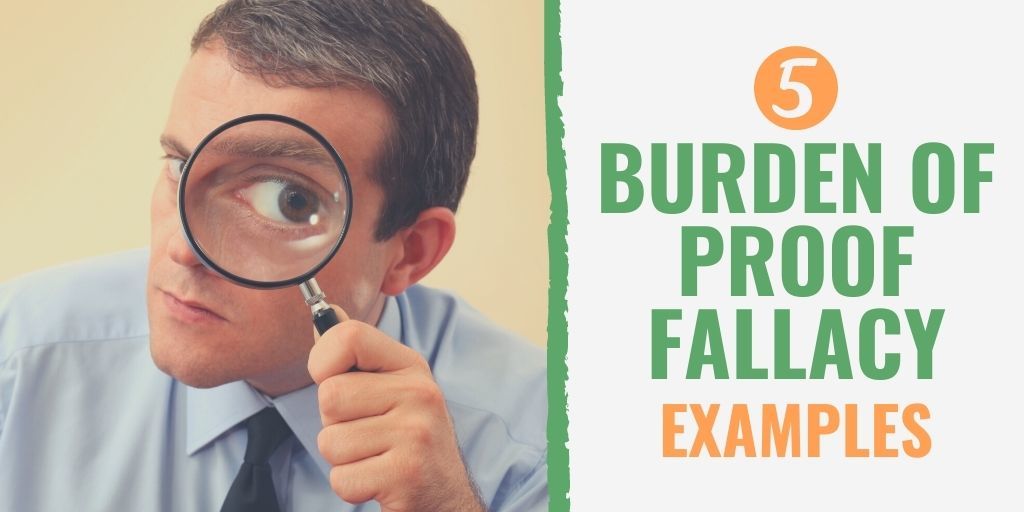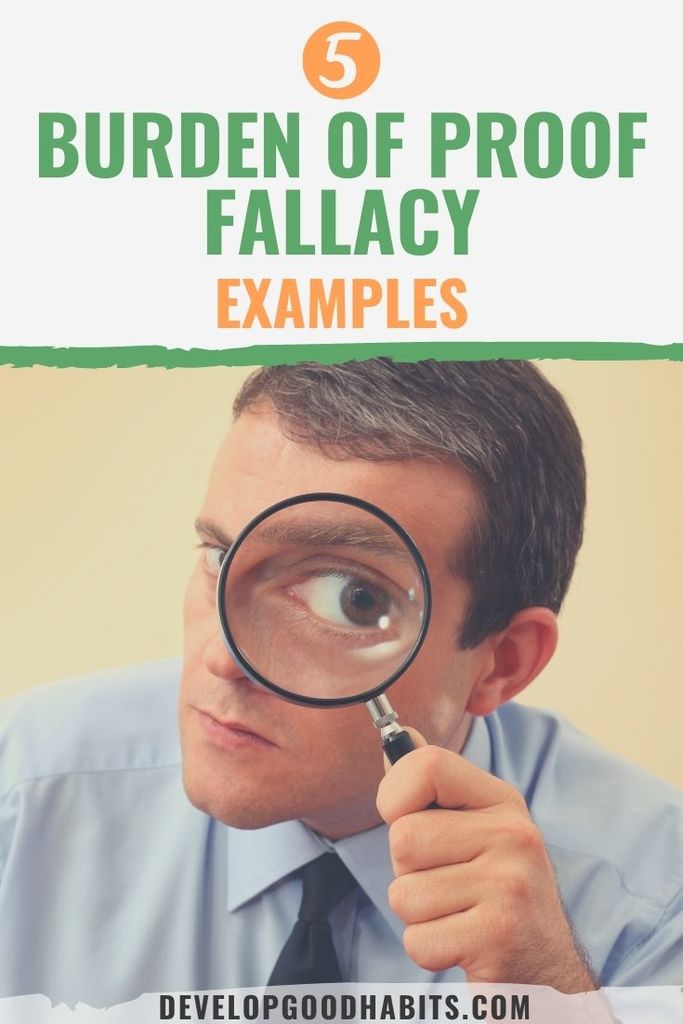There might be affiliate links on this page, which means we get a small commission of anything you buy. As an Amazon Associate we earn from qualifying purchases. Please do your own research before making any online purchase.
If you think about what the “burden of proof” means for a minute (or you look it up), it makes perfect sense. This is something that you probably face in one form or another every day.
While the concept of “the burden of proof” is commonly used in law, it also plays a critical role in real-world conversations and debates. In everyday discussions, the burden of proof is used to either increase or decrease how much someone else believes your claim. While you don’t have a “belief threshold” you need to surpass in everyday conversation (like you do in a legal debate), there are situations in which you want to convince another person that something is true (or false).
The burden of proof is the assumed responsibility you bring upon yourself to offer sufficient supporting evidence for your claims.
For example:
And if you don’t offer evidence to support your claims, you should be prepared for people to ask you why.
So why is the burden on the original claimant? Through life experience, you probably recognize that not everything that everyone says is true, whether the speaker knows it or not. Because of this, reasonable people look for valid reasons and evidence before believing a claim that is being asserted as the truth.
This means the burden of offering support falls on those who are making a claim. So if you make a claim and then pass the burden of proof off to the person you’re making the claim to, they’re likely to be at a loss for words.
In this article, we are going to take a deeper look at the definition of the misplaced burden of proof fallacy and then review 5 examples of when you may cross paths with this logical fallacy in your everyday life.
But first, let’s define this concept.
What Is the Burden of Proof Fallacy?
We recently learned about the appeal to ignorance fallacy, in which someone is making an argument that something is true simply because there’s no evidence that proves otherwise.
The burden of proof fallacy is very similar, and some logical fallacy experts don’t even make a distinction between the two. But there is one key difference: with the burden of proof fallacy, the speaker makes their assertion and then actively challenges the listener to prove them wrong, therefore shifting the burden from the speaker to the listener–while in the appeal to ignorance, this demand is merely assumed.
The misplaced burden of proof fallacy is a logical fallacy that takes place when someone tries to dodge their responsibility of providing proof of their claim, which is a central part of making an argument. They may do this in the following ways:
When carrying out a burden of proof fallacy, one may use any combination of the four tactics listed above.
This may take one of the following forms:
Person A: I claim X is true.
Person B: Prove it.
Person A: Can you prove it’s not true?
Or:
Person A: We should do A.
Person B: Why?
Person A: Why not?
In both of these forms, the assumption that something is true unless it’s proven otherwise is the source of the logical fallacy.
Sometimes using this logical fallacy can result in a “tug of war” of sorts, in which two opposing sides of an argument keep shifting the burden of proof back to the other side. This turns into a problem when there is no determination stating which side of the debate should rightly assume the burden. This can go back and forth until both sides recognize they’re at a stalemate.
Similar to the appeal to ignorance fallacy, those who use this logical fallacy are often making claims that can’t be proven or disproven by evidence, like claims regarding religion, miracles, or deities.
Let’s take a look at some examples.
5 Burden of Proof Fallacy Examples
1. “God (or martians, miracles, ghosts, Santa, fairies, etc) exists because no one has proven otherwise.”
If something (such as God, etc.) cannot be proven to be either true or false, it will remain unproven until there is evidence proving otherwise. One cannot prove nonexistence because knowing for certain something absolutely doesn’t exist would require omniscience–or the capacity to know everything–which would also require omnipresence.
Because this is impossible, claiming something absolutely doesn’t exist is unjustifiable. Logicians refer to these claims as “worldwide existential negatives” because they can’t be declared by any human through direct observation.
Our limits in proving negatives stop at our ability (and motivation) to spend time and energy observing what we can and being able to prove that there are no (martians, etc.) where we have looked up to this point within the limitation of our knowledge.
So claiming that something exists because no one can prove it doesn’t exist is unreasonable, as no one could ever prove an absolute absence of something.
2. Evading the Burden
This type of argument could be used about a variety of topics in various types of settings:
Here, person A is evading the burden of proof by redirecting it to a different source. The problem with this is twofold: first, we all know you can’t believe everything you read on the internet, and second, person A wasn’t able to offer any supporting facts himself.
When the burden of proof takes on this form, the burden is often attributed to an ambiguous source. I remember several years ago I was having dinner with a friend’s family and his sister said, “They are trying to make Spanish the primary language in America.”
My first thought was: Who are “they”?
She didn’t get much pushback from the table–and as a guest, I certainly wasn’t going to be the one to say anything–but it’s a dinner that I will not soon forget.
In this case, my friend’s sister was also demonstrating a denial of commitment, meaning she was supporting this claim without associating herself with it, which therefore helped her evade the burden of answering: What? Why? When? How? etc.
3. Marketing
Let’s say a company makes a claim that they have developed a safe and effective medication to treat an illness. The public will put the burden of proof on that company to provide data or results from clinical trials to support this claim. Without any type of proof, people will be hesitant to take the drug for fear of either side effects or wasted money if it’s simply ineffective.
This same rule goes for all marketing tactics. In fact, there are laws that protect consumers against being persuaded by advertising that doesn’t have any facts to back it up. According to the FTC, advertisers cannot make claims that are not substantiated, “especially when they concern health, safety, or performance…If your ad specifies a certain level of support for a claim – “tests show X” – you must have at least that level of support.”
This shows that the burden of proof falls on the sellers, who are responsible for the claims they make about whatever they’re selling. Furthermore, there are laws that prohibit third party advertising companies from making false claims about products as well. So not only can the burden of proof fall on the original company, it can also fall on those who help distribute their message.
The logical fallacy takes place when companies who are promoting a product either fail to provide necessary evidence or offer false claims.
4. Denying Responsibility
When the burden of proof falls on some, they deny it to try to get out of having to prove their statement. This could look like the following:
Consider what this could look like in a professional environment. Let’s say an employee tells her boss that someone has harassed her in the office. To protect all employees, her boss then asks her for proof to back up her claim. However, the employee then gets defensive, saying she doesn’t need to provide evidence of the harassment–saying that reporting harassment should be enough for her boss to take action.
Furthermore, she claims that her boss can’t prove that she wasn’t harassed, so that means it’s true.
But if you think logically, it’s easy to see that there is no way the boss can disprove her statement.
5. In Law
There are a lot of criticisms behind using this logical fallacy in legal hearings. Afterall, the idea of being “innocent until proven guilty” has probably let a lot of criminals off the hook.
This logical fallacy is criticized in the case of civil asset forfeiture. There are situations in which law enforcement officers can seize a citizen’s property that has been acquired unlawfully, such as a car or some other property purchased with money earned through the sale of drugs.
The issue arises when someone is asked to prove that their property was not gained through money earned illegally or that the cash they’re holding isn’t from the sale of drugs. Both of these things are almost impossible to prove, as there is no visible line between one’s money earned through a legitimate job and that same person’s money earned by selling drugs. This may cause someone to lose their property that was legally obtained.
How to Respond to the Burden of Proof Fallacy
So what should you do if you’re being asked to provide the proof for someone else’s claim? You have some options, depending on various factors, like the method the other person is using to evade their burden, whether or not there are other people present, and your goals for the debate.
First, make their error in reasoning clear by explaining what the burden of proof fallacy is and how they’re committing it by not backing up their claims.
Then explain why this burden is on them–not you–to prove their statement. Set your boundaries for the remainder of the conversation by saying you won’t entertain any more dialogue until they’ve done their work to offer evidence to back up their argument. If the person tries to evade this, point out exactly what the person is doing to avoid fulfilling this burden.
If they can’t fulfill this burden and you have counter-proof, go ahead and offer it. This can help in some situations, however, it’s not effective if the claim you’re responding to is difficult to disprove, as many claims that are coupled with the burden of proof fallacy are.
And sometimes, you may just have to ignore the other person if they’re trying to evade their burden, and just focus on what you know and believe. You can either agree to disagree if you believe the rest of your discussion could be productive, or you can just leave the discussion altogether if you no longer value it.
Finally, you can modify your responses as the conversation progresses. For example, if someone commits this fallacy and you call them out on it, you may choose how you proceed with the conversation depending on how they react. And, if there is someone else present, you can ask them to moderate the conversation to ensure both sides are fulfilling their burden.
If you are going into a discussion and this fallacy has not yet been committed, agree in advance on the expectations for fulfilling the burden of proof and the ultimate goal of the conversation. Setting these expectations from the beginning can also help prevent other communication issues and ensure everyone is on the same page from the start.
Final Thoughts on the Burden of Proof Fallacy
Similar to other cognitive biases, the burden of proof fallacy is a faulty method of reasoning, however, this one is more blatantly unconvincing than some others. Remember to always engage in your own critical thinking and explore alternatives to prevent yourself from falling for this type of argument.
Make a point to inform people when they’re committing this fallacy and that you’re not going to fall for it. If people know that others recognize their arguments are illogical, they’re more likely to do their own research and not spread false information.
Read More About Logical Fallacies
- 15 Cognitive Biases: A List of Common Biases Many People Have
- 5 Appeal to Nature Fallacy Examples in Media and Life
- 6 Outcome Bias Examples That Can Negatively Impact Your Decisions
- 7 Self-Serving Bias Examples You See Throughout Life
- 7 Omission Bias Examples That Negatively Impact Your Life
- 6 Authority Bias Examples That Might Impact Your Decisions
- 5 Appeal to Tradition Fallacy Examples in Life
- 5 Appeal to Authority Logical Fallacy Examples
- 7 False Cause Fallacy Examples
- 7 Appeal to Common Sense Logical Fallacy Examples
- 5 Post Hoc Fallacy Examples (and How to Respond to This Argument)
- Gambler’s Fallacy: 5 Examples and How to Avoid It
- 5 Appeal to Anger Fallacy Examples Throughout Life
- 7 Halo Effect Bias Examples in Your Daily Life
- 7 Poisoning the Well Examples Throughout Your Life
- 7 Survivorship Bias Examples You See in the Real World
- 7 Dunning Kruger Effect Examples in Your Life
- 7 Either Or (“False Dilemma”) Fallacy Examples in Real Life
- 5 Cui Bono Fallacy Examples to Find Out “Who Will Benefit”
- 6 Anchoring Bias Examples That Impact Your Decisions
- 7 Virtue Signaling Examples in Everyday Life
- 7 Cherry Picking Fallacy Examples for When People Ignore Evidence
- 9 Circular Reasoning Examples (or “Begging the Question”) in Everyday Life
- 9 Appeal to Emotion Logical Fallacy Examples
- 9 Appeal to Pity Fallacy (“Ad Misericordiam”) Examples in Everyday Life
- 9 Loaded Question Fallacy Examples in Life and Media
- 9 Confirmation Bias Fallacy Examples In Everyday Life
- 9 Bandwagon Fallacy Examples to Prevent Poor Decisions
- 5 Red Herring Fallacy Examples to Fight Irrelevant Information
- 9 Middle Ground Fallacy Examples to Spot During an Argument
- 5 False Equivalence Examples to Know Before Your Next Argument
- 7 Hasty Generalization Fallacy Examples & How to Respond to Them
- 6 Straw Man Fallacy Examples & How You Can Respond
- 6 False Dichotomy Examples & How to Counter Them
- 7 Slippery Slope Fallacy Examples (And How to Counter Them)
- What is the Planning Fallacy?
- How to Overcome the “Sunk Cost Fallacy” Mindset
Finally, if you want a simple process to counter the logical fallacies and cognitive biases you encounter in life, then follow this 7-step process to develop the critical thinking skills habit.

Connie Mathers is a professional editor and freelance writer. She holds a Bachelor's Degree in Marketing and a Master’s Degree in Social Work. When she is not writing, Connie is either spending time with her daughter and two dogs, running, or working at her full-time job as a social worker in Richmond, VA.



